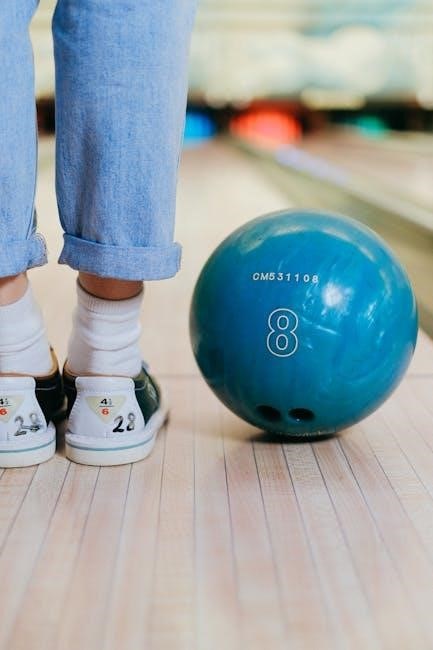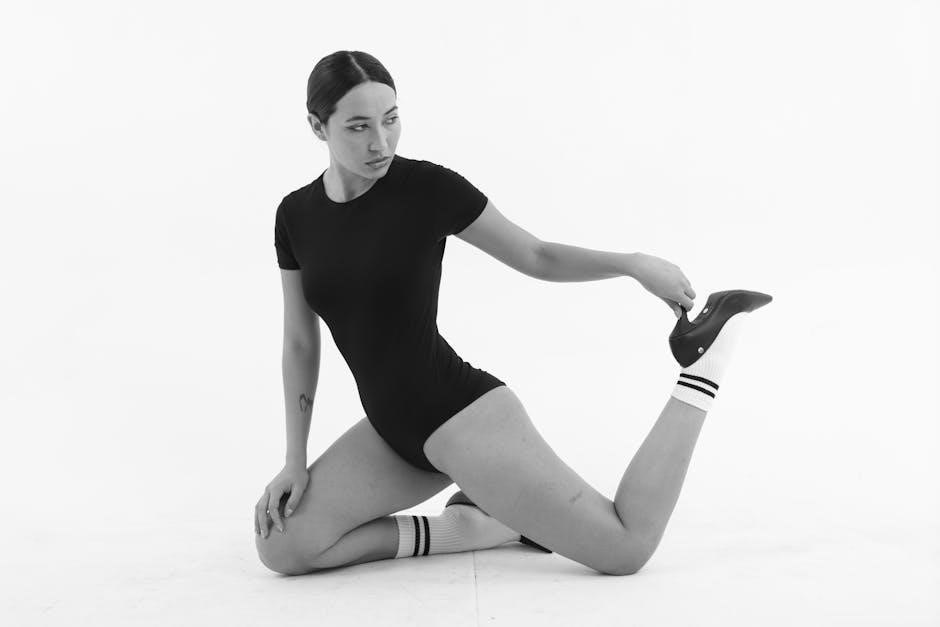Welcome to our comprehensive sock size guide, designed to help you find the perfect fit. Discover how to measure your feet, match shoe sizes, and choose the right fabric for comfort and performance.
Why Sock Size Matters
Sock size plays a crucial role in comfort, performance, and overall foot health. Ill-fitting socks can lead to discomfort, blisters, and even long-term foot issues like calluses or fungal infections. Properly sized socks ensure adequate support and cushioning, which are essential for daily activities, sports, and maintaining hygiene. Tight socks can restrict circulation, while loose ones may bunch up and cause friction. Additionally, the right size ensures optimal performance for specific activities, such as hiking or running, where moisture-wicking and breathability are key. Compression socks, in particular, require precise sizing to provide the correct pressure for medical benefits. Investing time in finding the right sock size ensures a better fit, enhanced comfort, and improved overall well-being. Whether for casual wear or athletic pursuits, correct sock sizing is a small detail that makes a big difference in how your feet feel throughout the day.
How to Use This Guide
This guide is designed to help you navigate the world of sock sizing with ease. Start by measuring your foot accurately using the step-by-step guide provided. Once you have your measurements, refer to the standard sock size charts to determine your size. Consider factors like fabric type, thickness, and intended use, as these can affect fit. For international sizes, use the conversion charts to ensure accuracy. If you’re purchasing compression socks, pay attention to compression levels and sizing tips specific to these products. For kids, use the age-to-size charts or measure their feet regularly, as sizes change quickly. Don’t forget to match your sock size to your shoe size for optimal comfort and performance. By following these steps, you’ll find the perfect fit for any occasion, ensuring comfort, support, and durability. Happy shopping!

Understanding Sock Sizing Systems
Sock sizing systems vary by region and brand, often correlating with shoe sizes. Some use numerical scales, while others rely on letter-based systems like S, M, or L. Understanding these systems ensures accurate fits.
Standard Sock Size Charts
Standard sock size charts typically align with shoe sizes, providing a consistent reference point for consumers. These charts often categorize sizes as Small, Medium, Large, and Extra-Large, each corresponding to specific shoe size ranges. For instance, a Small sock might fit shoe sizes 6-8, while an Extra-Large accommodates sizes 12-14. Some brands offer more precise sizing, including half sizes or additional categories like X-Small or XX-Large, to ensure a better fit. Material thickness and intended use, such as athletic or casual wear, can influence how sizes are defined. By matching your shoe size to these charts, you can determine your sock size accurately, ensuring comfort and preventing issues like blisters or restricted movement. Always refer to the specific brand’s chart, as sizing can vary slightly between manufacturers.
International Sizing Differences
Understanding international sizing differences is crucial when selecting socks, as standards vary globally. In Japan, sock sizes are often based on centimeter measurements, aligning closely with foot length. European sizes may follow a similar numeric or alphabetic system but can differ slightly from U.S. standards. For instance, a U.S. size 10 might correspond to a European size 44 or 45. The UK sizing system is another variation, often differing by half sizes compared to U.S. measurements. These discrepancies can affect fit, so it’s essential to consult size charts specific to the brand or region. Additionally, some countries prioritize shoe size correlation, while others focus on direct foot measurements. When shopping internationally, double-check the sizing guide to ensure accuracy. This variability highlights the importance of measuring your feet and comparing them to the brand’s chart for the best fit, regardless of regional sizing norms.

How to Measure Your Foot Accurately
Stand on a ruler, heel aligned with the edge. Measure the longest toe to determine length. Ensure foot is flat and measure both feet, using the larger size for comfort.
Step-by-Step Measurement Guide
To accurately measure your foot, start by gathering a ruler, a flat surface, and a piece of paper. Place the paper on the floor and stand on it, ensuring your heel aligns with the edge of the paper. Mark the tip of your longest toe with a pen. Measure the distance from the heel to this mark using the ruler. Record the measurement in centimeters or inches. Repeat for the other foot, as sizes may vary slightly. Use the larger measurement to determine your sock size. For the best fit, stand while measuring, as feet expand slightly with weight. Avoid measuring while seated, as this can lead to inaccurate results. Refer to a standard sock size chart to match your measurement to the appropriate size. This method ensures a precise fit, eliminating discomfort from tight or loose socks.
How Foot Shape Affects Sock Size
Foot shape plays a significant role in determining the perfect sock size. While length is the primary factor, width, arch height, and toe shape also influence fit. For instance, individuals with wider feet may require a larger size to avoid tightness, while those with narrower feet might need a snugger fit to prevent slipping. High arches can affect how socks hug the foot, potentially requiring a slightly different size for optimal comfort. Similarly, toe shape—whether rounded, pointed, or square—can impact how socks fit around the toes. People with uniquely shaped feet may benefit from specialized socks designed for their specific foot type. Accurate measurements and understanding your foot shape are essential for selecting socks that provide both comfort and support. By considering these factors, you can ensure a tailored fit that enhances your overall comfort throughout the day.

Matching Shoe Size to Sock Size
Matching shoe size to sock size ensures optimal comfort and fit. Shoe size typically corresponds to foot length, while sock size may vary by material, height, and brand. Use a size chart to find your perfect match.
Correlation Between Shoe and Sock Sizes
While shoe size is a helpful starting point for determining sock size, it’s important to recognize that they don’t always align perfectly. Shoe size primarily reflects foot length, while sock size accounts for foot circumference, heel-to-toe measurement, and material thickness. For example, thicker socks may require a slightly larger size to maintain comfort, even if your shoe size remains the same. Additionally, sock height and activity level can influence fit, with athletic socks often requiring a snugger fit to prevent slipping during movement. To ensure the best fit, refer to a size chart specific to the brand and style of sock you’re purchasing, as sizing can vary between manufacturers. By considering both shoe size and sock-specific factors, you can achieve a more accurate and comfortable fit.
How Sock Thickness Impacts Fit
Sock thickness plays a significant role in determining comfort and fit. Thicker socks, often used for cold weather or high-impact activities, provide additional cushioning but can take up more space in your shoe. This may require adjusting your size to ensure a comfortable fit. Conversely, thinner socks are ideal for snug-fitting shoes or everyday wear, offering a more precise fit without bulk. The material weight of the sock can also affect how it stretches and conforms to your foot. For example, compression socks are designed to be tighter and provide support, while athletic socks may have varying thickness depending on their intended use. Choosing the right thickness ensures your socks stay in place, prevent blisters, and maintain breathability. Always consider both the activity and shoe type when selecting sock thickness to achieve the best fit and performance.

Fabric and Material Considerations
Fabric and material choices significantly impact sock fit and comfort. Natural fibers like cotton and wool offer breathability, while synthetic materials enhance durability and moisture-wicking properties. Understanding these differences helps you select socks tailored to your needs and preferences.
Common Sock Materials and Their Properties
Socks are made from a variety of materials, each offering unique benefits. Cotton is breathable and soft, ideal for everyday wear, while wool provides warmth and insulation, perfect for cold weather. Synthetic materials like polyester and nylon are durable, moisture-wicking, and often used in athletic socks. Blends, such as cotton-polyester mixes, combine softness with enhanced durability. Bamboo socks are eco-friendly, naturally antibacterial, and moisture-wicking. Silk socks offer luxury and softness but are less durable. Thicker materials like fleece or thermal yarns are designed for cold conditions, while lightweight fabrics like nylon or spandex provide a snug, flexible fit. Understanding the properties of these materials helps you choose socks that align with your lifestyle, activity level, and personal comfort preferences, ensuring the best fit and performance for your needs.
How Fabric Weight Affects Sizing
Fabric weight significantly impacts sock sizing and fit. Heavier fabrics, such as wool or thick synthetics, can make socks feel tighter due to their density and reduced stretch. This may require sizing up for comfort. Lightweight materials, like nylon or silk, offer more flexibility and a looser fit, potentially allowing you to size down. Thicker fabrics are often used for warmth or cushioning, while lighter ones prioritize breathability and moisture-wicking properties. The weight of the fabric also influences how it conforms to your foot shape, affecting overall comfort and performance. When selecting socks, consider both the activity and the fabric weight to ensure the best fit. Always check size charts, as brands may vary in how they accommodate different fabric weights. Ignoring fabric weight can lead to socks that are too tight or too loose, compromising comfort and functionality. Choose wisely to enjoy optimal fit and performance.

Sock Height and Length
Socks come in various heights, from no-show to knee-high, catering to different preferences and activities. The right length ensures comfort, support, and style, making it essential to choose based on your needs and lifestyle.
Understanding Different Sock Heights
Socks come in various heights to suit different activities, preferences, and shoe types. No-show socks are ideal for casual wear, sitting below the shoe line for a sleek look. Crew socks, the most common, offer versatility and comfort, typically reaching mid-calf. Mid-calf socks provide additional support and are popular for sports or work. Knee-high socks extend to the knee, offering warmth and compression, often used in colder weather or for medical purposes. Over-the-calf socks stay in place longer, suitable for formal or athletic wear. Each height serves specific needs, ensuring comfort and functionality. Understanding these options helps you choose the right pair for your lifestyle and activities, ensuring optimal fit and performance.
How Activity Level Affects Sock Length Choice
Your activity level significantly influences the ideal sock length. For high-intensity activities like running or hiking, opt for crew or mid-calf socks to provide sufficient support and cushioning. These lengths reduce blisters and offer moisture-wicking properties, enhancing performance. During casual outings or everyday wear, no-show or low-cut socks are preferable for their breathability and discreet fit. For sports requiring additional stability, such as cycling or basketball, knee-high socks can provide compression and warmth. In colder environments, longer socks like over-the-calf options are ideal for insulation. Additionally, activities like yoga or CrossFit benefit from mid-calf socks that stay in place during dynamic movements. Selecting the right sock length based on your activity ensures comfort, prevents discomfort, and improves overall performance, making it a crucial consideration for any lifestyle or sport.

Compression Socks: Special Considerations
Compression socks offer targeted support, often used for medical or athletic needs. Higher compression levels require precise sizing to avoid discomfort. Breathable fabrics enhance durability and comfort during extended wear.
Understanding Compression Levels
Compression socks are designed to provide varying levels of pressure, typically measured in mmHg (millimeters of mercury). The most common levels are 15-20 mmHg for mild support and 20-30 mmHg for moderate compression. Higher levels, such as 30-40 mmHg, are often used for medical purposes, like treating swelling or varicose veins. The compression level you choose depends on your activity level, health needs, and personal comfort. Always ensure your compression socks fit correctly, as improper sizing can lead to discomfort or reduced effectiveness. Look for breathable materials to enhance comfort during extended wear. For athletes, higher compression levels can improve blood flow, while casual wearers may prefer lighter support. Consult a size chart to match your shoe size with the appropriate compression level for optimal results. Proper fit ensures maximum benefits and prevents potential issues like tightness or restricted movement.
How to Choose the Right Compression Sock Size
Choosing the right compression sock size is crucial for both comfort and effectiveness. Start by using a size chart specific to the brand, as sizes can vary slightly between manufacturers. Measure your shoe size and calf circumference, as these are key factors in determining the best fit. Compression socks are designed to fit snugly but not overly tight, so ensure the size aligns with your activity level and personal comfort preferences. For example, athletes may prefer a firmer fit, while casual wearers might opt for a more relaxed compression level. Additionally, consider the sock’s material and thickness, as these can affect how it feels throughout the day. If you’re unsure, try on several sizes or consult with a professional fitter, especially for medical-grade compression socks. Proper sizing ensures optimal performance, comfort, and health benefits, making it worth the time to get it right.
Kids’ Sock Sizing
Kids’ sock sizing is based on shoe size and age, ensuring a comfortable fit as they grow. Measure their feet regularly and refer to size charts for accurate selection.
How to Measure Kids’ Feet
Measuring your child’s feet accurately is essential for finding the right sock size. Start by having your child stand on a flat surface with their weight evenly distributed. Use a ruler or a Brannock device to measure the length of their foot from the heel to the longest toe. Ensure the foot is relaxed, not arched or curled. For younger children, you can trace their foot on paper and measure the tracing. Always measure both feet, as they may differ slightly, and use the larger measurement to ensure comfort. Consider your child’s activity level, as thicker socks may require a slightly larger size. Repeat the process every few months, as children’s feet grow rapidly. This ensures a proper fit and prevents discomfort or blisters. Accurate measurements are key to selecting socks that support growth and provide all-day comfort.
Age vs. Shoe Size for Kids’ Socks
While shoe size is the most reliable indicator for choosing kids’ socks, age can sometimes serve as a general guide. Toddler sizes often align with early childhood ages, while youth sizes correspond to older children. However, foot growth varies significantly among kids, so relying solely on age can be inaccurate. For younger children, sizes are often categorized by age ranges, such as 0-2 years or 3-5 years, but this method becomes less precise as kids grow older. For older children, shoe size is a more accurate measure. Parents should measure their child’s foot regularly, as growth spurts can occur rapidly. Combining age with shoe size provides a better estimate, but always double-check the fit to ensure comfort and proper support. This dual approach helps in selecting socks that accommodate growth and activity levels effectively.

Caring for Your Socks
Proper care ensures longevity and fit. Wash socks in cold water to prevent shrinkage and fabric degradation. Avoid harsh detergents to maintain elasticity and softness. Air-drying is recommended for optimal durability.
Washing Tips to Maintain Fit
Proper washing is essential to maintain the fit and quality of your socks; Always wash them in cold water, as hot water can cause shrinkage and stretch the fabric. Use a mild detergent to avoid damaging the material, especially for delicate or compression socks. Avoid using fabric softeners, as they can reduce the elasticity of the fibers. For best results, turn your socks inside out before washing to protect the outer fabric from friction. Do not bleach, as it can weaken the material and cause discoloration. After washing, remove excess water gently without wringing, and reshape the socks to their original form. Air-drying is recommended, as machine drying can lead to shrinkage and wear. Following these care tips ensures your socks remain comfortable, retain their size, and last longer, providing the best fit and performance.
How Fabric Degradation Affects Size
Fabric degradation can significantly impact the size and fit of your socks over time. Natural fibers like cotton may shrink when exposed to hot water, while synthetic materials like nylon or polyester can stretch or lose elasticity due to repeated washing and wear. Harsh detergents or excessive heat from drying can weaken fabric fibers, causing socks to sag or lose their shape. Additionally, prolonged use can lead to friction-based wear, especially in high-stress areas like the heel and toe. This degradation can result in socks feeling too loose or tight, even if they initially fit perfectly. To combat this, choose high-quality materials designed for durability and follow proper care routines, such as washing in cold water and avoiding machine drying. By understanding how fabric degradation affects size, you can extend the life of your socks and maintain their optimal fit;
Finding the perfect sock size ensures comfort, performance, and longevity. By understanding sizing systems, measuring accurately, and considering fabric and activity levels, you can make informed choices for your footwear needs.
Choosing the right sock size is crucial for comfort and performance; Start by measuring your foot accurately, using a sizing chart tailored to your shoe size. Consider factors like fabric type, thickness, and activity level, as these impact fit. International sizing variations mean comparing charts is essential. Compression socks require precise measurements for effectiveness. For kids, age and shoe size correlations help determine the best fit. Proper care, including washing techniques, maintains sock shape and comfort over time. By aligning these elements, you can ensure a perfect fit, enhancing both comfort and durability. Remember, the right size and material can make a significant difference in your daily activities and overall satisfaction with your footwear.
Final Tips for Finding Your Perfect Sock Size
To ensure the best fit, always measure your feet accurately and refer to size charts specific to the brand or type of sock. Consider your activity level and choose fabrics that align with your needs, whether for comfort, durability, or moisture-wicking properties. If shopping internationally, be aware of sizing differences and compare charts to find your match. For compression socks, prioritize precise measurements to ensure proper support. When caring for your socks, follow washing guidelines to maintain their shape and elasticity. Lastly, don’t hesitate to try different sizes or styles until you find the perfect fit—comfort and performance depend on it!